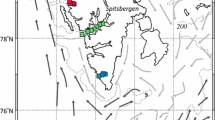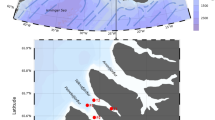Abstract
The abundance and vertical distribution of zooplankton in the mesopelagic zone are important to better understand their role in carbon and energy transfer in the Southern Ocean ecosystem. In the austral summer of 2012/2013, in Prydz Bay, Antarctica, the vertical profiles of zooplankton community structures between 0 and 1500 m were investigated by multivariate analysis of samples collected using a Hydro-Bios MultiNet (200-µm mesh, 0.5 m2 mouth size). Four zooplankton communities belonging to distinct water strata were identified. Group 1 contained samples collected from the surface water strata (<100 m) of four shelf and neritic stations. Group 2 was composed of samples collected from the neritic and shelf regions (<500 m) and the upper layers (0–200 m) of the oceanic region. Group 3 mainly comprised samples collected from the mesopelagic and upper bathypelagic zones (200–1500 m) of shelf and oceanic stations north of the shelf break edge. Group 4 consisted of samples in the 1000–1500 m water stratum of three oceanic stations. The four groups differed more in animal abundance than in species composition. Similarity percentage analysis (SIMPER) showed that zooplankton communities in the upper depth strata (0–200 m) had higher abundance and more pronounced dissimilarity within samples than those below 200 m. A few species (Metridia gerlachei, Rhincalanus gigas, Alacia spp.) showed significant diel vertical migration based on quadratic regression analysis. Sampling depth was the strongest differentiating factor between samples. These results suggest that depth-related differences in environmental characteristics of water masses, such as temperature and salinity, may have the greatest effect upon community structure.





Similar content being viewed by others
References
Albers C, Kattner G, Hagen W (1996) The composition of wax esters, triacylglycerols and phospholipids in Arctic and Antarctic copepods: evidence of energetic adaptations. Mar Chem 55:347–358
Arrigo KR, Van Dijken GL (2003) Phytoplankton dynamics within 37 Antarctic coastal polynya systems. J Geophys Res 108:3271
Atkinson A (1998) Life cycle strategies of epipelagic copepods in the Southern Ocean. J Mar Syst 15:289–311
Atkinson A, Peck JM (1988) A summer-winter comparison of zooplankton in the oceanic area around South Georgia. Polar Biol 8:463–473
Atkinson A, Sinclair JD (2000) Zonal distribution and seasonal vertical migration of copepod assemblages in the Scotia Sea. Polar Biol 23:46–58
Atkinson A, Ward P, Williams R, Poulet SA (1992) Feeding rates and diel vertical migration of copepods near South Georgia: comparison of shelf and oceanic sites. Mar Biol 114:49–56
Blachowiak-Samolyk K, Angel MV (2007) A year round comparative study on the population structure of pelagic ostracods in Admiralty Bay (Southern Ocean). Hydrobiologia 585:67–77
Brugnano C, Bergamasco A, Granata A, Guglielmo L, Zagami G (2010) Spatial distribution and community structure of copepods in a central Mediterranean key region (Egadi Islands–Sicily Channel). J Mar Syst 81:312–322
Chiba S, Ishimaru T, Hosie GW, Fukuchi M (2001) Spatio-temporal variability of zooplankton community structure off east Antarctica (90 to 160°E). Mar Ecol Prog Ser 216:95–108
Clarke KR, Ainsworth M (1993) A method of linking multivariate community structure to environmental variables. Mar Ecol Prog Ser 92:205–219
Clarke KR, Gorley RN (2006) Primer v6: user manual/tutorial. PRIMER-E, Plymouth
Daase M, Eiane K (2007) Mesozooplankton distribution in northern Svalbard waters in relation to hydrography. Polar Biol 30:969–981
Daly KL, Macaulay MC (1991) Influence of physical and biological mesoscale dynamics on the seasonal distribution and behavior of Euphausia superba in the Antarctic marginal ice zone. Mar Ecol Prog Ser 79:37–66
Dubischar CD, Lopes RM, Bathmann UV (2002) High summer abundances of small pelagic copepods at the Antarctic Polar Front—implications for ecosystem dynamics. Deep-Sea Res II 45:3871–3887
Dufrene M, Legendre P (1997) Species assemblages and indicator species: the need for a flexible asymmetrical approach. Ecol Monogr 67:345–366
Errhif A, Razouls C, Mayzaud P (1997) Composition and community structure of pelagic copepods in the Indian sector of the Antarctic Ocean during the end of the austral summer. Polar Biol 17:418–430
Field JG, Clarke KG, Warwick RM (1982) A practical strategy for analyzing multispecies distribution patterns. Mar Ecol Prog Ser 8:37–52
Flores H, Hunt BPV, Kruse S, Pakhomov EA, Siegel V, van Franeker JA, Strass V, Van de Putte AP, Meesters EHWG, Bathmann U (2014) Seasonal changes in the vertical distribution and community structure of Antarctic macrozooplankton and micronekton. Deep-Sea Res I 84:127–141
Hernandez-Leon S, Portillo-Hahnefeld AP, Almeida C, Becognee P, Moreno I (2001) Diel feeding behaviour of krill in the Gerlache Strait, Antarctica. Mar Ecol Prog Ser 223:235–242
Hopkins TL (1985a) The zooplankton community of Croker Passage, Antarctic Peninsula. Polar Biol 4:161–170
Hopkins TL (1985b) Food web of an Antarctic midwater ecosystem. Mar Biol 89:197–212
Hopkins TL, Torres JJ (1988) The zooplankton community in the vicinity of the ice edge, western Weddell Sea, March 1986. Polar Biol 9:79–87
Hosia A, Stemmann L, Youngbluth M (2008) Distribution of net-collected planktonic cnidarians along the northern Mid-Atlantic Ridge and their associations with the main water masses. Deep-Sea Res II 55:106–118
Hosie GW, Cochran TG (1994) Mesoscale distribution patterns of macrozooplankton communities in Prydz Bay, Antarctica—January to February 1991. Mar Ecol Prog Ser 106:21–39
Hosie GW, Stolp M (1989) Krill and zooplankton in the western Prydz Bay region, September–November 1985. Proc NIPR Symp Polar Biol 2:34–45
Hosie GW, Cochran TG, Pauly T, Beaumont KL, Wright SW, Kitchener JA (1997) Zooplankton community structure of Prydz Bay, Antarctic, January–February 1993. Proc NIPP Symp Polar Biol 10:90–133
Hosie GW, Schultz MB, Kitchener JA, Cochran TG, Richards K (2000) Macrozooplankton community structure off East Antarctica (80–150°E) during the Austral summer of 1995/1996. Deep-Sea Res II 47:2437–3463
Hosie GW, Fukuchi M, Kawaguchi S (2003) Development of the Southern Ocean Continuous Plankton Recorder Survey. Prog Oceanogr 58:263–283
Hunt BPV, Hosie GW (2003) The Continuous Plankton Recorder in the Southern Ocean: a comparative analysis of zooplankton communities sampled by the CPR and vertical net hauls along 140°E. J Plankton Res 25:1–19
Hunt BPV, Hosie GW (2005) Zonal structure of zooplankton communities in the Southern Ocean South of Australia: results from a 2150 km continuous plankton recorder transect. Deep-Sea Res I 52:1241–1271
Hunt BPV, Hosie GW (2006) The seasonal succession of zooplankton in the Southern Ocean south of Australia, part I: the seasonal ice zone. Deep-Sea Res I 53:1182–1202
Hunt BPV, Pakhomov EA, Trotsenko BG (2007) The macrozooplankton of the Cosmonaut Sea, east Antarctica (30°E–60°E), 1987–1990. Deep-Sea Res I 54:1042–1069
Ikeda T, Yamaguchi A, Matsuishi T (2006) Chemical composition and energy content of deep-sea calanoid copepods in the Western North Pacific Ocean. Deep-Sea Res I 53:1791–1809
Jonasdottir SH, Nielsen TG, Borg CMA, Moller EF, Jakobsen HH, Satapoomin S (2013) Biological oceanography across the Southern Indian Ocean—basin scale trends in the zooplankton community. Deep-Sea Res I 75:16–27
Kosobokova K, Hirche HJ (2000) Zooplankton distribution across the Lomonosov Ridge, Arctic Ocean: species inventory, biomass and vertical structure. Deep-Sea Res I 47:2029–2060
Kosobokova K, Hopcroft RR (2010) Diversity and vertical distribution of mesozooplankton in the Arctic’s Canada Basin. Deep-Sea Res II 57:96–110
Laakmann S, Auel H (2010) Longitudinal and vertical trends in stable isotope signatures (δ13C and δ15N) of omnivorous and carnivorous copepods across the South Atlantic Ocean. Mar Biol 157:463–471
Laakmann S, Stumpp M, Auel H (2009) Vertical distribution and dietary preferences of deep-sea copepods (Euchaetidae and Aetieidae; Calanoida) in the vicinity of the Antarctic Polar Front. Polar Biol 32:679–689
Lopez MDG, Huntley ME (1995) Feeding and diel vertical migration cycles of Metridia gerlachei (Giesbrecht) in coastal waters of the Antarctic Peninsula. Polar Biol 15:21–30
Marin V (1988) Qualitative models of the life cycles of Calanoides acutus, Calanus propinquus, and Rhincalanus gigas. Polar Biol 8:439–446
Marrari M, Daly KL, Timonin A, Semenova T (2011) The zooplankton of Marguerite Bay, western Antarctic Peninsula—part II: vertical distributions and habitat partitioning. Deep-Sea Res II 58:1614–1629
Metz C (1995) Seasonal variation in the distribution and abundance of Oithona and Oncaea species (Copepoda, Crustacea) in the southeastern Weddell Sea, Antarctica. Polar Biol 15:187–194
Michels J, Schnack-Schiel SB, Pasternak A, Mizdalski E, Isla E, Gerdes D (2012) Abundance, population structure and vertical distribution of dominant calanoid copepods on the eastern Weddell Sea shelf during a spring phytoplankton bloom. Polar Biol 35:369–386
Nunes Vaz RA, Lennon GW (1996) Physical oceanography of the Prydz Bay region of Antarctic waters. Deep-Sea Res I 43:603–641
Pond DW, Tarling GA (2011) Phase transitions of wax esters adjust buoyancy in diapausing Calanoides acutus. Limnol Oceanogr 56:1310–1318
Schmidt K, Atkinson A, Steigenberger S, Fielding S, Lindsay MCM, Pond DW, Tarling GA, Klevjer TA, Allen CS, Nicol S, Achterberg EP (2011) Seabed foraging by Antarctic krill: implications for stock assessment, bentho-pelagic coupling, and the vertical transfer of iron. Limnol Oceanogr 56:1411–1428
Schnack-Schiel SB, Hagen W (1994) Life cycle strategies and seasonal variations in distribution and population structure of four dominant calanoid copepod species in the eastern Weddell Sea, Antarctica. J Plankton Res 16:1543–1566
Schnack-Schiel SB, Hagen W, Mizdalski E (1991) A seasonal comparison of Calanoides acutus and Calanus propinquus (Copepoda: Calanoida) in the southeastern Weddell Sea, Antarctica. Mar Ecol Prog Ser 70:17–27
Schnack-Schiel SB, Michels J, Mizdalski E, Schodlok MP, Schroder M (2008) Composition and community structure of zooplankton in the sea ice-covered western Weddell Sea in spring 2004—with emphasis on calanoid copepods. Deep-Sea Res II 55:1040–1055
Schulz J, Peck MA, Barz K, Schmidt JO, Hansen FC, Peters J, Renz J, Dickmann M, Mohrholz V, Dutz J, Hirche HJ (2012) Spatial and temporal habitat partitioning by zooplankton in the Bornholm Basin (central Baltic Sea). Prog Oceanogr 107:3–30
Shi JX, Dong ZQ, Chen HX (2013) Progress of Chinese research in physical oceanography of the Southern Ocean. Adv Polar Sci 24(2):86–97
Smith NR, Dong ZQ, Kerry KR, Wright S (1984) Water masses and circulation in the region of Prydz Bay, Antarctica. Deep-Sea Res 31:1121–1147
Smith S, Roman M, Prusova I, Wishner K, Gowing M, Codispoti LA, Barber R, Marra J, Flagg C (1998) Seasonal response of zooplankton to monsoonal reversals in the Arabian Sea. Deep-Sea Res II 45:2369–2403
Swadling KM, Kawaguchi S, Hosie GW (2010) Antarctic mesozooplankton community structure during BROKE-West (30°E–80°E). Deep-Sea Res II 57:887–904
Terazaki M (1989) Distribution of chaetognaths in the Australian sector of the Southern Ocean during the BIOMASS SIBEX cruise (KH-83-4). Proc NIPR Symp Polar Biol 2:51–60
Ward P, Tarling GA, Thorpe SE (2014) Mesozooplankton in the Southern Ocean: spatial and temporal patterns from Discovery Investigations. Prog Oceanogr 120:305–319
Williams WJ, Carmack EC, Ingram RG (2007) Physical oceanography of polynyas. In: Smith WO Jr, Barber DG (eds) Polynyas: windows to the world. Elsevier, Amsterdam, pp 55–86
Williams GD, Nicol S, Aoki S, Meijers AJS, Bindoff NL, Iijima Y, Marsland SJ, Klocker A (2010) Surface oceanography of BROKE-West, along the Antarctic margin of the south-west Indian Ocean (30–80°E). Deep-Sea Res II 57:738–757
Yang G, Li CL, Sun S (2011a) Inter-annual variation in summer zooplankton community structure in Prydz Bay, Antarctica, from 1999 to 2006. Polar Biol 34:921–932
Yang G, Li CL, Sun S (2011b) Population dynamics of four dominant copepods in Prydz Bay, Antarctica, during austral summer from 1999 to 2006. Chin J Oceanol Limnol 29:1065–1074
Acknowledgments
We would like to thank the crew of R.V. Xuelong for their assistance in the field. We are grateful to the Polar Biology Repository of the Marine Biological Museum of the Chinese Academy of Sciences (MBMCAS) for providing samples. We would like to thank Jiuxin Shi for help with water mass analysis. We thank Yong Jiang for assistance with NMDS analysis. This research was supported by polar project of SOA, China (CHINARE2015-01-05-02, CHINARE2016-01-05-02 and CHINARE2016-04-01-05).
Author information
Authors and Affiliations
Corresponding author
Electronic supplementary material
Below is the link to the electronic supplementary material.
Rights and permissions
About this article
Cite this article
Yang, G., Li, C., Wang, Y. et al. Vertical profiles of zooplankton community structure in Prydz Bay, Antarctica, during the austral summer of 2012/2013. Polar Biol 40, 1101–1114 (2017). https://doi.org/10.1007/s00300-016-2037-4
Received:
Revised:
Accepted:
Published:
Issue Date:
DOI: https://doi.org/10.1007/s00300-016-2037-4




